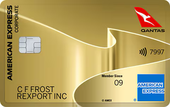
The lowdown.
What is a gold credit card?
A gold credit card is a premium card that sits above standard credit cards, offering enhanced rewards, exclusive perks, and typically higher credit limits. Designed for those seeking more than the basics, these cards often come with benefits like travel insurance, rewards programs, and concierge services.
However, gold credit cards are less common in Australia today, with many issuers shifting to platinum or black credit cards. Still, a few gold cards remain on the market for personal and business users.

Personal. Business. Corporate.
Different types of gold credit cards
Gold credit cards vary depending on their target audience and features. Here’s a breakdown of the main types available in Australia:
- Personal gold cards. These cater to individuals and often include rewards points, travel perks, and complimentary insurance. Examples include cards with gold branding, like certain American Express or Visa options, though they may not always use “gold” in the name.
- Business gold cards. Aimed at small business owners, these cards offer rewards tailored to business spending, such as points on office supplies or travel, plus features like expense tracking. Most gold cards in Australia fall into this category.
- Corporate gold cards. Marketed for larger organisations, these are less common and typically offered through corporate banking relationships.

How to compare gold credit cards
To find the right gold credit card, weigh the benefits against the costs. Here’s what to consider when you compare side-by-side:
1. Rewards
- Bonus points offers. Many gold cards entice new customers with sign-up bonus points (e.g., 50,000 points after spending a set amount). Check the eligibility criteria to ensure you can meet the requirements.
- Earn rates. Rewards programs differ across cards. For instance, American Express cards often earn 1–2 points per $1 spent, while Visa or Mastercard options may offer 0.5–1 point. Frequent flyer programs, like Qantas Points, Velocity Points, are also common.
- Points caps. Some cards cap the points you can earn monthly or annually. If you’re a high spender, opt for an uncapped card. For average spenders, calculate your monthly spending to see if a cap will limit your rewards.
2. Rates and fees
- Interest rates. Gold card purchase rates typically range from 12% to 24% p.a. Some offer introductory 0% rates for 6–12 months, ideal for big purchases if you can pay them off before the rate reverts.
- Interest-free days. Most gold cards provide up to 44–55 interest-free days per statement period, but only if you clear the balance in full. Charge cards, like some American Express options, require full repayment within a set period (e.g., 51 days) instead of charging interest.
- Annual fees. Fees vary widely, from no annual fee to around $400. Compare the fee against the card’s perks to ensure value. Low-fee gold cards exist but may offer fewer benefits.
- Credit limits. Gold cards often start with minimum limits of $1,000–$5,000, with maximums reaching $20,000 or more, depending on your income and credit score.
3. Other ‘gold’ benefits
- Complimentary insurance. Many gold cards include international travel insurance, purchase protection, or extended warranties. Always review the policy details, as coverage and activation requirements (e.g., paying for travel with the card) vary.
- Concierge services. A 24/7 concierge can assist with booking flights, securing restaurant reservations, or arranging event tickets.
- Airport lounge access. Some gold cards offer complimentary airport lounge passes or Priority Pass, adding comfort to your travels.
Exclusive offers
- Visa premium. Access discounts on dining, travel, and entertainment.
- Mastercard Priceless. Enjoy unique experiences, from VIP events to travel perks.
- Amex offers. Save on shopping, dining, and more through tailored deals.
- Global support. Lost your card overseas? Global assistance services can help replace it or provide emergency funds.

Too good to be true?
Are gold credit cards worth it?
Deciding if a gold credit card is right for you depends on your spending habits, lifestyle, and financial goals. Ask yourself these questions:
- How much do you spend monthly? Gold cards shine for frequent spenders. For example, spending $2,500 monthly on a card earning 1 point per $1 could yield 30,000 points annually. If those points redeem for a $150 gift card, but the card’s annual fee is $120, you’re ahead. Low spenders may find the fees outweigh the rewards.
- Will you use the perks? Benefits like earning frequent flyer points, travel insurance or lounge access are only valuable if you use them. For instance, complimentary travel insurance could save you $200 per trip, offsetting a $150 annual fee, but it’s wasted if you rarely travel.
- Can you afford the costs? Higher annual fees and credit limits require discipline. Ensure the fee fits your budget and you can pay off the balance to avoid interest. If the minimum credit limit (e.g., $5,000) feels risky, consider a standard card instead.
If a gold card’s costs outweigh its value, explore alternatives like low-rate cards for affordability or platinum cards for more premium perks.



